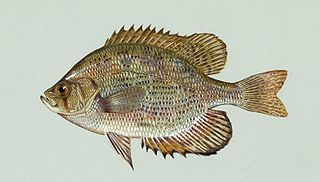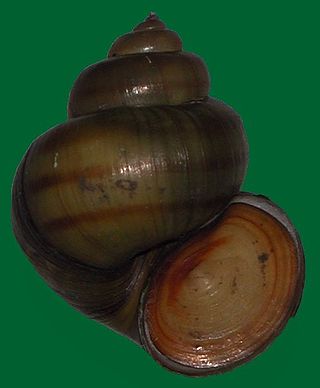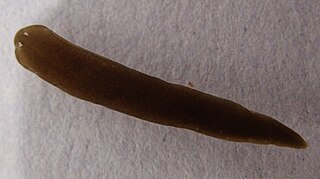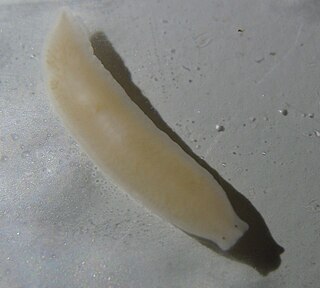
Centrarchidae, better known as sunfishes, is a family of freshwater ray-finned fish belonging to the order Perciformes, native only to North America. There are eight universally included genera within the centrarchid family: Lepomis, Micropterus, Pomoxis (crappies), Enneacanthus, Centrarchus, Archoplites, Ambloplites, and Acantharchus. A genetic study in 2012 suggests that the highly distinct pygmy sunfishes of the genus Elassoma are also centrarchids.

Planarians (triclads) are free-living flatworms of the class Turbellaria., order Tricladida, which includes hundreds of species, found in freshwater, marine, and terrestrial habitats. Planarians are characterized by a three-branched intestine, including a single anterior and two posterior branches. Their body is populated by adult stem cells called neoblasts, which planarians use for regenerating missing body parts. Many species are able to regenerate any missing organ, which has made planarians a popular model in research of regeneration and stem cell biology. The genome sequences of several species are available, as are tools for molecular biology analysis.

Ampullariidae, whose members are commonly known as apple snails, is a family of large freshwater snails that includes the mystery snail species. They are aquatic gastropod mollusks with a gill and an operculum. These snails simultaneously have a gill and a lung as functional respiratory structures, which are separated by a division of the mantle cavity. This adaptation allows these animals to be amphibious. Species in this family are considered gonochoristic, meaning that each individual organism is either male or female.

Planaria is a genus of planarians in the family Planariidae.

The white-lipped snail or garden banded snail, scientific name Cepaea hortensis, is a large species of air-breathing land snail, a terrestrial pulmonate gastropod mollusc in the family Helicidae. The only other species in the genus is Cepaea nemoralis.

Autotomy or 'self-amputation', is the behaviour whereby an animal sheds or discards one or more of its own appendages, usually as a self-defense mechanism to elude a predator's grasp or to distract the predator and thereby allow escape. Some animals have the ability to regenerate the lost body part later. Autotomy has multiple evolutionary origins and is thought to have evolved at least nine times independently in animals. The term was coined in 1883 by Leon Fredericq.

Bulinus is a genus of small tropical freshwater snails, aquatic gastropod mollusks in the family Bulinidae, the ramshorn snails and their allies.

Cornu aspersum, known by the common name garden snail, is a species of land snail in the family Helicidae, which includes some of the most familiar land snails. Of all terrestrial molluscs, this species may well be the most widely known. It was classified under the name Helix aspersa for over two centuries, but the prevailing classification now places it in the genus Cornu.

Viviparidae, sometimes known as the river snails or mystery snails, are a family of large operculate freshwater snails, aquatic gastropod mollusks.

A land snail is any of the numerous species of snail that live on land, as opposed to the sea snails and freshwater snails. Land snail is the common name for terrestrial gastropod mollusks that have shells. However, it is not always easy to say which species are terrestrial, because some are more or less amphibious between land and fresh water, and others are relatively amphibious between land and salt water.

Geoplanidae is a family of flatworms known commonly as land planarians or land flatworms.

Theba pisana, common names the white garden snail, sand hill snail, white Italian snail, Mediterranean coastal snail, and simply just the Mediterranean snail, is an edible species of medium-sized, air-breathing land snail, a terrestrial pulmonate gastropod mollusk in the family Helicidae, the typical snails.
The sensory organs of gastropods include olfactory organs, eyes, statocysts and mechanoreceptors. Gastropods have no sense of hearing.

Pachychilidae, common name pachychilids, is a taxonomic family of freshwater snails, gastropod molluscs in the clade Sorbeoconcha.

Freshwater snails are gastropod mollusks that live in fresh water. There are many different families. They are found throughout the world in various habitats, ranging from ephemeral pools to the largest lakes, and from small seeps and springs to major rivers. The great majority of freshwater gastropods have a shell, with very few exceptions. Some groups of snails that live in freshwater respire using gills, whereas other groups need to reach the surface to breathe air. In addition, some are amphibious and have both gills and a lung. Most feed on algae, but many are detritivores and some are filter feeders.

Biomphalaria sudanica is a species of air-breathing freshwater snail, an aquatic pulmonate gastropod belonging to the family Planorbidae, the ram's horn snails. Biomphalaria sudanica has a discoidal, brown shell with an approximate shell diameter of 9–11mm. Biomphalaria sudanica is a medically important pest, due to it being an intermediate host of the intravascular trematode genus, Schistosoma.
Girardia tigrina, known as the brown planarian or the immigrant triclad flatworm, is a species of dugesiid native to the Americas. It has been accidentally introduced into Europe and Japan.

Schmidtea polychroa is a species of freshwater flatworm, a dugesiid triclad that inhabits the shallow mesotrophic or eutrophic waters of rivers and lakes of Europe. It is also present in North America, where it has been introduced at least in the Saint Lawrence river system. It is an animal with a limited dispersion capability.
Schmidtea lugubris is a species of freshwater flatworm, a dugesiid triclad found in Europe.

Dendrocoelum lacteum, the milk-white planarian, is a freshwater planarian found in lakes and running waters in Europe, being the most widespread freshwater planarian in this continent.

















